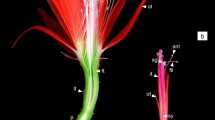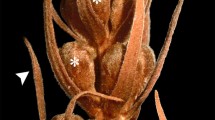Abstract
Floral organogenesis had previously been investigated thoroughly in 11 species from three of nine subtribes or their equivalent in the Commelinaceae. Here flower morphology and development is described from a member of a fourth subtribe, Tinantia pringlei from the Thyrsantheminae, and comparisons are made. Although the calyx is only weakly monosymmetric at maturity, development is of the monosymmetric-type known from or resembling that of the monosymmetric flowers of Cochliostema, Dichorisandra, and Plowmanianthus (subtribe Dichorisandrinae; tribe Tradescantieae) and Commelina (tribe Commelineae). Whereas the corolla also is weakly monosymmetric at maturity, development is of the polysymmetric-type known from the polysymmetric flowers of Callisia, Gibasis, and Tradescantia (subtribe Tradescantiinae). In the androecium, the long, inconspicuous blue stamens of the lower floral hemisphere emerge first during development, while the shorter, showy yellow, upper stamens emerge last. The overall pattern of stamen development is centripetal, thereby resembling that reported for the majority of confamilial taxa, and contrasting with the centrifugal pattern known from Callisia and Tradescantia. Relative to the majority of confamilial taxa investigated, the carpels emerge relatively late in development, resembling the timing known for the carpels of Callisia and Tradescantia. Overall, however, carpel emergence in Tinantia pringlei is unique in the comparatively small size of the remnant floral apical primordium on which the carpels emerge. Other variations in floral development are discussed and further such studies within the family are encouraged based on the potential for using such developmental variations in the assessment of morphological homologies and phylogenetic relationships within the Commelinaceae.





Similar content being viewed by others
Literature Cited
Faden, R. B. 1992. Floral attraction and floral hairs in the Commelinaceae. Annals of the Missouri Botanical Garden 79: 46–52.
——— 1998. Commelinaceae. Pp 109–128. In: K. Kubitzki (ed). The families and genera of vascular plants, Vol. 4. Springer, Berlin.
——— 2000. Floral biology of Commelinaceae. Pp 309–317. In: K. L. Wilson & D. A. Morrison (eds). Monocots. Systematics and evolution. CSIRO Publishing, Collingwood.
Hardy, C. R. J. I. Davis & D. W. Stevenson. 2004. Floral organogenesis in Plowmanianthus (Commelinaceae). International Journal of Plant Sciences 165: 511–519.
———, L. L. Sloat & R. B. Faden. 2009. Floral Organogenesis and The developmental basis for pollinator deception in the Asiatic dayflower Commelina communis (Commelinaceae). American Journal of Botany 96.
——— & D. W. Stevenson. 2000a. Development of the flower, gametophytes, and floral vasculature in Cochliostema odoratissimum (Commelinaceae). Botanical Journal of the Linnean Society 134: 131–157.
——— & ———. 2000b. Floral organogenesis in some species of Tradescantia and Callisia (Commelinaceae). International Journal of Plant Sciences 161: 551–562.
———, ——— & H. G. Kiss. 2000. Development of the flower, gametophytes, and floral vasculature in Dichorisandra thyrsiflora (Commelinaceae). American Journal of Botany 87: 1228–1239.
Holmgren, P. K. & N. H. Holmgren. 1998 [continuously updated]. Index Herbariorum: A global directory of public herbaria and associated staff. New York Botanical Garden’s Virtual Herbarium. http://sweetgum.nybg.org/ih/.
Hunt, D. R. 1975. Tinantia pringlei. Curtis’s botanical magazine 180: 161–164.
Masters, M. T. 1872. On the development of the androecium in Cochliostema, Lem. Proceedings of the Linnean Society (Botany) 13: 204–209.
Parks, M. 1935. Embryo sac development and cleistogamy in Commelinantia pringlei. Bulletin of the Torrey Botanical Club 62: 91–104.
Payer, J.-B. 1857. Traite’ d’organoge’nie compare’e de la fleur. Masson, Paris.
Prychid, C. J., C. A. Furness & P. J. Rudall. 2003. Systematic significance of cell inclusions in Haemodoraceae and allied families: silica bodies and tapetal raphides. Annals of Botany 92: 571–580.
Rohweder, O. 1963. Anatomische und histogenetische Untersuchungen an Laubsprossen und Blüten der Commelinaceen. Botanische Jahrbücher fur Systematik, Pflanzengeschichte und Pflanzengeographie 82: 1–99.
Simpson, B. B., J. L. Neff & G. Dieringer. 1986. Reproductive biology of Tinantia anomala (Commelinaceae). Bulletin of the Torrey Botanical Club 113: 149–158.
Stevenson, D. W. & S. J. Owens. 1978. Some aspects of the reproductive morphology of Gibasis venustula (Kunth) D.R. Hunt (Commelinaceae). Botanical Journal of the Linnean Society 77: 157–175.
Tomlinson, P. B. 1966. Anatomical data in the classification of Commelinaceae. Botanical Journal of the Linnean Society 59: 371–395.
Vogel, S. 1978. Evolutionary shifts from reward to deception in pollen flowers. Pp 89–104. In: A. J. Richards (ed). The pollination of flowers by insects. Linnean Society Symposium Series No. 6. Academic, New York.
Acknowledgments
This article is dedicated to Dr. Dennis Wm. Stevenson, academic mentor and dear friend of the first author of this article. Dennis Stevenson was notably influential in introducing the first author to the study of floral morphology and development in the Commelinaceae and monocots generally, as well as to the microscopic techniques employed here. It is indeed fitting that the current study represents a collaborative effort, in much the same tradition, on the part of the first author and one of his own students, Jason Ryndock. In addition, the biologist and illustrator responsible for Fig. 1, Zel Stoltzfus, also is a former student of the first author.
Financial support for this study came from the Millersville University Department of Biology and an Arthur and Claribel Gerhart Scholarship award to Jason Ryndock. To that end, we appreciate Susan DiBartolomeis and James Moné for their service on the Gerhart Scholarship Selection Committee. David Dobbins and Maria Schiza provided invaluable assistance through their efforts in the maintenance of the scanning electron microscope. The plants used in this study were generated from stem cuttings originally donated by Bob and Audrey Faden out of the Smithsonian Institution’s greenhouse facility. It is the maintenance of such living collections that enables this type of research.
Author information
Authors and Affiliations
Corresponding author
Rights and permissions
About this article
Cite this article
Hardy, C.R., Ryndock, J. Floral Morphology and Organogenesis in Tinantia pringlei, Along with a Review of Floral Developmental Variation in the Spiderwort Family, Commelinaceae. Bot. Rev. 78, 416–427 (2012). https://doi.org/10.1007/s12229-012-9108-1
Published:
Issue Date:
DOI: https://doi.org/10.1007/s12229-012-9108-1




